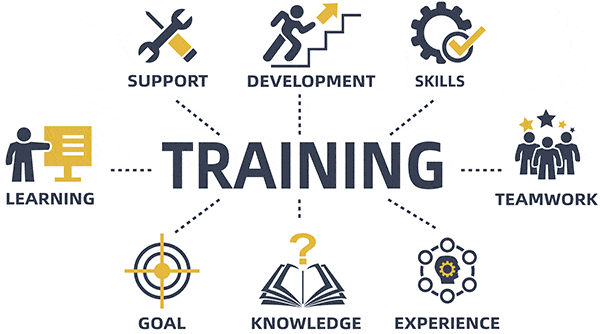
The SAFE-T-TRAIN© Process
SAFE-T-TRAIN
The importance of safety training cannot be overstated in any industry or workplace. It serves as a critical foundation for maintaining the well-being of employees, the integrity of the business, and the overall success of operations. Here are some key reasons why Transformatioanl Safety believes safety training is of utmost importance:
- Worker Safety: Safety training equips employees with the knowledge and skills necessary to identify and mitigate workplace hazards. This reduces the risk of accidents and injuries, ensuring that employees can perform their duties in a secure environment.
- Legal Compliance: Many regulatory authorities require businesses to provide safety training to their employees. Non-compliance with these regulations can result in fines, legal actions, and damage to the organization’s reputation.
- Cost Reduction: Proper safety training can significantly reduce costs related to workplace accidents, such as medical bills, workers’ compensation claims, and potential lawsuits. It also minimizes the expenses associated with equipment damage and downtime.
- Improved Productivity: When employees are trained in safety protocols, they are more confident and efficient in their roles. This can lead to increased productivity and better job satisfaction.
- Enhanced Reputation: Businesses known for their commitment to safety are often more attractive to customers, investors, and prospective employees. A strong safety record can boost a company’s reputation and marketability.
- Risk Management: Safety training helps organizations identify and manage risks. By proactively addressing potential hazards, they can prevent incidents and minimize the impact of unexpected events.
- Crisis Preparedness: In the event of an emergency, such as a fire, natural disaster, or health crisis, employees with proper safety training are better prepared to respond effectively, potentially saving lives and reducing damage.
- Long-Term Sustainability: Prioritizing safety creates a culture of care and responsibility within an organization. This can lead to reduced turnover, as employees are more likely to stay with an employer that values their well-being.
- Environmental Responsibility: Safety training often includes elements of environmental awareness and sustainability, promoting responsible practices that benefit the planet.
- Humanitarian Considerations: Above all, safety training demonstrates an organization’s commitment to the health and safety of its workforce. This is not only a moral obligation but also a fundamental aspect of corporate social responsibility.

Training programs for workplace safety are an investment that organizations cannot afford to overlook. By prioritizing employee training, organizations demonstrate their commitment to creating a secure work environment, enhancing employee well-being, and protecting their bottom line. Comprehensive training fosters a culture of safety, equips employees with the necessary skills and knowledge to prevent accidents, and ensures compliance with regulations. Ultimately, a well-trained workforce is the cornerstone of a safe and successful organization.
Transformational Safety® holds firmly to the view that any effective psycho-behavioural safety management system must involve continuous training in the workplace safety procedures that employees are expected to follow – these might be called Principles of Operation.
Further to that operational training, Transformational Safety® ensures that all employees receive developmental training in the competencies associated with the application of the Transformational Safety® Leadership Model. At the operator level we refer to this as Transformational Communication.
In actual fact the “T” that you find referenced in all the SAFE-T-SOS© Psycho-Behavioural Technologies modules refer specifically to the application of the Transformational Safety® Leadership (TSL) competencies within the underlying framework of the System itself. It is the integration of the Transformational Safety® Model within the SAFE-T-SOS© Psycho-Behavioural System that adds a level of pro-active discretionary safety behaviour within the safety system itself.
If you would like to read the United States Occupational Health & Safety Administration’s (OSHA) view on the importance of safety training just Click Here.
To read more about the SAFE-T-SOS Psycho-Behavioral Technologies just Click Here.
“Most organizations operate in failure states and that just remains invisible because bad stuff is not happening. We might call that the ‘normalization of deviance’ and, make no mistake, it will kill.”

Ricky, Atlanta
![]()
“I was fortunate to attend Transformational Safety’s Anatomies of Disaster Program. This was amongst the most powerful two days I have ever spent in a room. From the outset David Broadbent set the scene by dedicating the program to the late Rick Rescorla – the man who is credited with saving over 2700 lives on 9/11. Throughout the two days David would often respectively reflect and remember those who had died, or been injured, in the disasters we explored. He would say, and I will never forget, “…we must always remember those that lost their lives lift us up into the light of understanding”. I learnt so much. HRO, Resilience Engineering, Critical Incident Stress Management (CISM) and more. Those of us who were there are still talking about it…… Thankyou David


